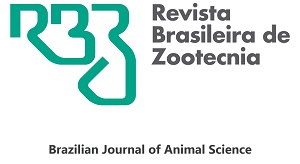Resumo em Inglês:
The objective of this study was to evaluate the chemical composition of leaves of maniçoba (Manihot sp.) according to their development stage and their relationship with the soil characteristics. For this purpose, plants in their natural growth areas in the semiarid region of Paraíba State, Brazil, were sampled. Leaves of maniçoba collected in five different locations at four different development stages were harvested and characterized: expanding leaf, completely expanded leaf, leaf at the beginning of senescence and a pool (mixture of all leaves). The evaluated traits were: dry matter, crude protein, neutral detergent fiber, acid detergent fiber, neutral detergent insoluble protein, acid detergent insoluble protein, ash, lignin, cellulose, hemicellulose, nitrogen, potassium, phosphorus, sulfur and sodium. The experimental design adopted was completely randomized, in a 4 × 5 factorial arrangement: four leaf development stages and five locations, respectively; each plot had 10 replications. There was interaction effect between leaf development stage and locations on dry matter, crude protein, neutral detergent insoluble protein and acid detergent insoluble protein. The results for neutral detergent fiber of leaves at the beginning of senescence were higher than other treatments and similar to the pool, while the acid detergent fiber content of the leaves in early senescence was higher than those of other treatments, averaging 34.8%. Crude protein content had its highest percentage in expanding leaves, averaging 23.0%. Nitrogen, potassium and sodium data showed interaction between the leaf types and locations of harvest, while phosphorus and sulfur did not show interaction. The chemical and mineral composition of maniçoba leaves range according to their development phase and according to their soil and climatic conditions in places of natural occurrence, with a tendency towards reduction of nitrogen and phosphorus as they approach senescence.
